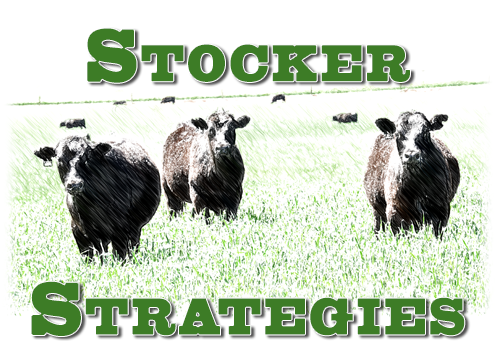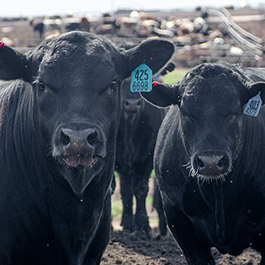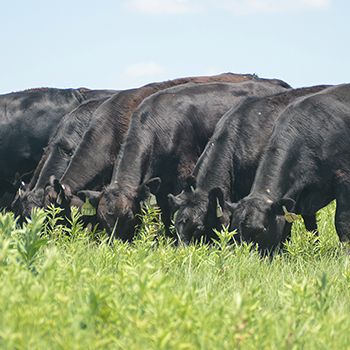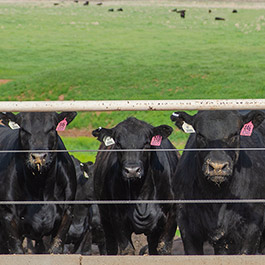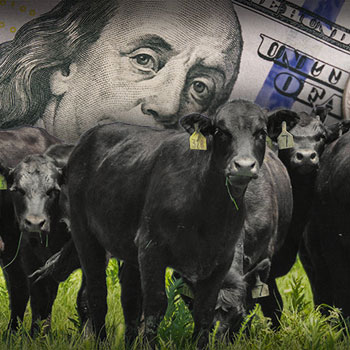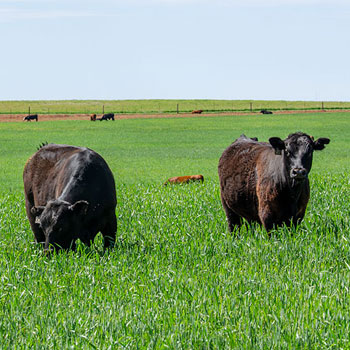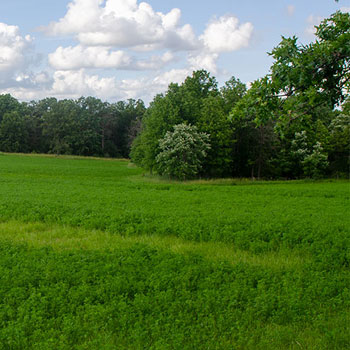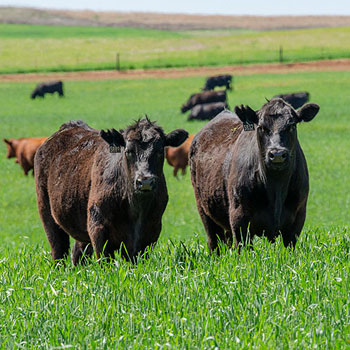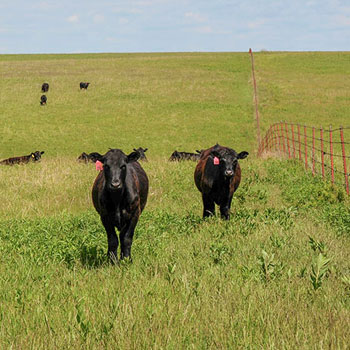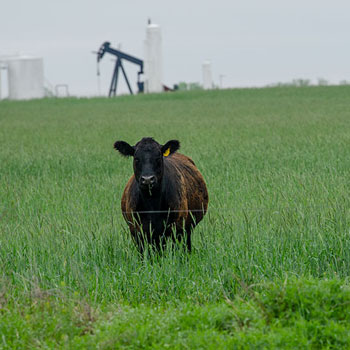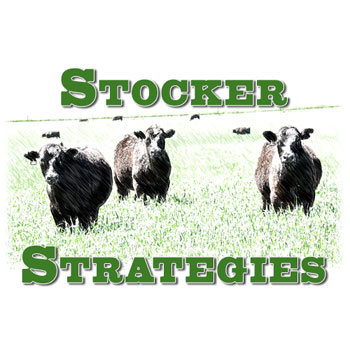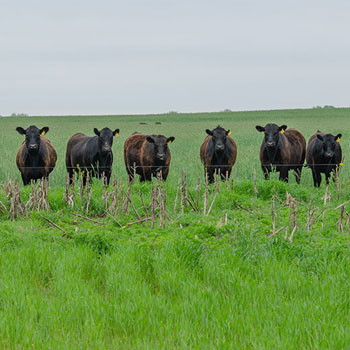Angus Advisor
Our team of Angus advisors offer regional tips for herd management for the spring season.
Southern Great Plains
david.lalman@okstate.eduSpring-calving herds Current recommended estrous synchronization protocols for beef cows can be found at https://beefrepro.unl.edu/resources.html. Protocols recommended for cows must be implemented a minimum of 10 days prior to the first planned artificial insemination (AI) date. Recommended protocols for heifers require anywhere from 7 to 36 days implementation prior to the first planned AI date.
An excellent review by Perry and Smith describes the current state of knowledge related to many different factors influencing success of synchronization and AI systems.
Consult your veterinarian about timing and product selection related to vaccination of cows prior to implementing an AI program. There is growing evidence that modified-live products administered within about 45 days prior to insemination may reduce success rate.
If cattle must be moved to a different location after AI, they should be transported within four days. One experiment documented decreased pregnancy loss when heifers were transported one to four days after insemination compared to later transportation. In the Southern Great Plains region, heat stress is possible during mid- to late-spring, especially during times of high humidity. Therefore, care must be taken to avoid compounding transportation stress with heat stress. In situations where animals will not be in transit for more than an hour, transportation during early daylight hours is advisable. Longer trips may require predawn or nighttime transportation.
Fewer females show signs of estrus during heat stress. For this reason, AI programs in this region planned for mid- to late-spring may benefit from using a timed AI (TAI) protocol rather than estrous detection.
Substantial evidence suggests that radical changes in diet and activity around the time of AI can reduce conception rates. In general, a consistent, slightly positive plane of nutrition combined with minimal change in activity during the AI and post-AI period facilitates AI success. This presents a special challenge because in many production systems in this region, forage green-up occurs at about the same time as the start of the breeding season. In seedstock operations, cattle are commonly moved to larger pastures or rangeland from a smaller pasture or drylot where they were being fed purchased and harvested feeds, and/or where they were more accessible for the synchronization and AI program. In those situations, daily travel distance (activity) and diet quality are likely to change. Managers should consider strategies to minimize sudden changes and certainly to avoid periods of rapid weight loss, which is common upon turnout on “washy” early-spring forage.
Similarly, it is advisable to adapt breeding bulls to pasture conditions prior to turnout with cows. Don’t forget to schedule breeding soundness exams (sometimes referred to as BSE) with your veterinarian.
Fall-calving herds Our industry has been absolutely victorious in terms of creating “curve-bender” cattle. In other words, dystocia has been radically reduced over the last 30 to 40 years while growth performance and carcass weights have been dramatically improved. The same can be accomplished with mature cow size. We now have the selection tools available to create moderate-sized mature cows with tremendous postweaning performance. You can speed our progess by taking a few extra moments at weaning or processing time to capture individual cow weight, hip height and body condition score (BCS) records each year. This can be accomplished within 45 days of weaning if it isn’t convenient on weaning day.
Determine your preferred timing for weaning, and inventory veterinary, feed and supplement supplies for the weaning program.
A coccidiostat is an important consideration in situations where calves will be concentrated in small pastures or drylots during the weaning period, especially on properties that have a history of coccidiosis.
General recommendations New-generation ear tags are highly effective in controlling horn flies. To minimize the buildup of resistance, rotate the chemical class of tags used annually. Justin Talley, assistant professor in the Department of Entomology and Plant Pathology at Oklahoma State University, recommends a rotation consisting of abamectin (year 1), organophosphate (year 2) and pyrethroid (year 3).
Follow label directions for number of tags per cow and per calf. In many cases, two tags per cow with no tag in the calf is the most effective strategy. Calves receive adequate product from the cow. In Talley’s work, April application resulted in better season-long control compared to later application.
Plan to remove ear tags as soon as possible once their effectiveness begins to decline.
Insect growth regulators (IGR) to be used in free-choice mineral products should be initiated in April before the fly population builds. A high percentage of the herd must consume the mineral consistently for this strategy to be effective. Neighboring cattle with heavy fly infestations will reduce the effectiveness of this strategy.
Introduced warm-season forages, such as Bermuda grass and Old World bluestem, should be fertilized in late April through mid-May. Approximately 50 pounds (lb.) of nitrogen (N) is required to produce about 1 ton of forage. Efficiency of nitrogen use is improved with multiple applications (generally two or three).
Check with your extension educator or forage agronomist to determine the most effective herbicide treatment to control sericea lespedeza. Be sure to read the herbicide label for the most effective rate and timing of application. Other tools to help manage this invasive legume species include late-season prescribed fire and management-intensive grazing with goats.
Western Region
randyp@csufresno.eduFall–calving herds Main focus: Cows and calves are on cruise control.
- Start planning for preweaning vaccinations.
- Continue your mineral supplementation program. Consider injectable mineral products in addition to loose, block and tub mineral products.
- This is the time of the year when fall-calving cows and calves should have very few problems with animal health.
- Spring is an excellent time of the year to work on general maintenance, such as repairing and building fences and other facilities. Also if irrigated pastures are part of your pasture resources during the summer months, this is the time to make repairs to irrigation systems before they are needed later in the spring.
Spring–calving herds Main focus: Prepare for the breeding season.
- Decide on AI sires and get semen ordered early to avoid last-minute problems with semen delivery. The most important decision each year in a purebred operation is sire selection.
- Consider all information and try to find the bulls that combine expected progeny differences (EPDs), genomics, phenotypic traits and “old-fashioned” convenience traits like longevity, udder structure, disposition, mothering ability, and feet and leg soundness.
- Decide on a synchronization protocol if estrous synchronization is going to be used in your operation. Many excellent systems are available and many of the TAI protocols offer very satisfactory results.
- Heat detection is the key to a good AI program, unless you are using a TAI system.
- Don’t overlook the importance of good and precise semen handling.
- Get bulls semen- and trichomoniasis-tested far in advance of the breeding season. If problems arise, replacement bulls can be located.
- Focus on becoming a better grazing manager — it can have a huge effect on your bottom line.
- Mineral supplementation is extremely important at this time of the year. I have discussed in detail in previous columns all of the different options available in this area.
- Try to maintain the optimum level of body condition through the calving and breeding season.
- Normally by late spring, forage resources are at their peak from both an energy and protein standpoint. Therefore, supplemental feeding is usually not needed at this time of the year.
- Make certain that females and service sires are vaccinated at least 30 days prior to the start of the breeding season.
- Treatment protocols and products should be on hand for both scours and pneumonia in suckling calves.
- Late spring is a good time to spray fencelines and get irrigation ditches or lines in good repair if irrigated pasture or hay fields are part of your operation.
Southeast Region
jduggin@uga.eduImagine a scenario where someone goes into a new fast-casual restaurant and after gazing at the menu, they decide to order the #2 Cull-Cow Burger Combo with fries and a milkshake. Then after sitting down, the person eating says to themself, “This cull cow is really good.” Obviously this doesn’t literally happen, but that doesn’t mean it doesn’t from a practical sense, at least in some form. Market cows and bulls, also known as cull cows and bulls on the farm, are a lesser-understood part of the industry. Better yet, imagine the droves of people at a lower-cost buffet somewhere thinking this 7-year-old cow really has some good flavor. Yep, that’s likely a market cow they’re eating and it could very well come from your operation.
To borrow a quote from the National Beef Quality Audit’s (NBQA) Market Cow and Bull Executive Summary, “People don’t know that cows and bulls supply beef to the industry,” according to a foodservice operator. The effect and importance of market cows and bulls on the beef industry is immense. Beef Quality Assurance (BQA) applies to the entire herd year-round. As a keeper of the land and cattle, the beef producers practicing good stockmanship and stewardship are the most valuable part of the industry.
Open cows aren’t the worst-case scenario on our operations. Lame, nonambulatory, and dead cows or herd bulls are much worse. The healthy, ambulatory cows in our beef herds are food in the form of nutritious beef and, as such, are valuable parts of the farm income. Producers who want to capture every dollar possible on market cows and bulls must have a heightened awareness of this part of the beef industry.
If someone asks the question, “What should my operation do to improve this food/beef product?” The short answer is to manage cow herds with the same focus and mentality as our calf crops. Just like on the feeder-cattle side, we must constantly be aware of the importance of the BQA guidelines for general welfare, chute processing, hauling and nutritional status. Keeping these management practices forefront ensures two things: 1) healthy, nutritious beef for the consumer whether they are in another country or our own family and friends; 2) improved economic sustainability on our operations with fewer frustrations.
Most likely you want a real-world answer as well. Here is a quote that is worth storing in our memory banks, “Foreign materials such as broken needles can still be an issue, as can buckshot and birdshot (found in carcasses). We should provide economic pushback down the chain to solve these issues,” says a packer interviewed from the NBQA Market Cow and Bull Audit.
Most beef producers are BQA-certified. If you or the cattle-working crew at your operation haven’t been certified or need renewed, please make it a priority. It may even help improve herd management, and will certainly improve the health and welfare of your herd. Be a keeper!
Midwest Region
baileyeric@missouri.eduSpring is upon us and the new year’s calf crop is taking shape. Many producers sell calves at weaning and pounds pay the bills. Yet many producers are leaving roughly $30 per head on the table, by not utilizing implants in suckling calves. Vestal et al. (2007) reported that only 37% of cow-calf producers with herds of larger than 100 cows implanted steer calves, and only 9% of producers with herds less than 100 cows implanted steer calves. Suckling calf implants increase calf weaning weight by 20 pounds (lb.) per head. A 600-lb. steer in Missouri was worth $165 in April 2019. At an implant cost of $2 per head and a return of $33 per head, how does an extra approximately $30 per head at weaning sound?
Implants do not require changes in management, other than administration when calves are worked in the spring. The calf utilizes nutrients provided by milk and forage more efficiently. Implant status of calves sold through Superior Livestock between 2010 and 2013 had no effect on sale price in a recent analysis by Rogers et al. (2015). Research by Pritchard et al. (2015) demonstrated that implanting suckling calves did not negatively alter subsequent feedyard performance or carcass quality. The beef industry has been able to lower its carbon footprint by 16% compared to 1977 (www.beefresearch.org/sustainability/) partially through the adoption of technologies used to enhance efficiency. It is a textbook “win-win.” The cow-calf producer increases revenue and enhances sustainability of the entire industry.
Producers need to consider a number of factors when selecting implant strategies. To ensure reproductive issues do not arise, simply avoid implanting breeding stock. Branding offers a convenient time to administer an implant. Calves are generally 90 days of age at branding, well above the 30- to 45-day age requirement of most implants and still three to four months from weaning.
The payout period of most calf implants is 100 to 120 days, so make sure when you plan to wean is not well after the end of the payout window. Otherwise, the advantage provided by the implant is diminished. If it is, consider an implant with a longer payout window. Implanting suckling calves is an underutilized, yet easy way of adding revenue to cow-calf operations across the country.
